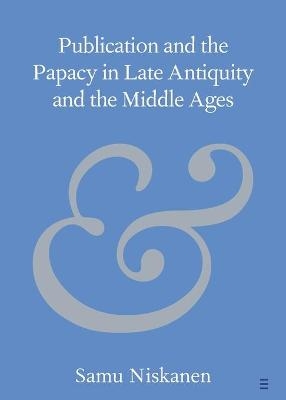
Publication and the Papacy in Late Antiquity and the Middle Ages
Seiten
2022
Cambridge University Press (Verlag)
978-1-009-11108-9 (ISBN)
Cambridge University Press (Verlag)
978-1-009-11108-9 (ISBN)
This Element explores the papacy's engagement in authorial publishing in late antiquity and the Middle Ages. The opening discussion demonstrates that throughout the medieval period, papal involvement in the publication of new works was a phenomenon, which surged in the eleventh century. This title is also available as Open Access on Cambridge Core.
This Element explores the papacy's engagement in authorial publishing in late antiquity and the Middle Ages. The opening discussion demonstrates that throughout the medieval period, papal involvement in the publication of new works was a phenomenon, which surged in the eleventh century. The efforts by four authors to use their papal connexions in the interests of publicity are examined as case studies. The first two are St Jerome and Arator, late antique writers who became highly influential partly due to their declaration that their literary projects enjoyed papal sanction. Appreciation of their publication strategies sets the scene for a comparison with two eleventh-century authors, Fulcoius of Beauvais and St Anselm. This Element argues that papal involvement in publication constituted a powerful promotional technique. It is a hermeneutic that brings insights into both the aspirations and concerns of medieval authors. This title is also available as Open Access on Cambridge Core.
This Element explores the papacy's engagement in authorial publishing in late antiquity and the Middle Ages. The opening discussion demonstrates that throughout the medieval period, papal involvement in the publication of new works was a phenomenon, which surged in the eleventh century. The efforts by four authors to use their papal connexions in the interests of publicity are examined as case studies. The first two are St Jerome and Arator, late antique writers who became highly influential partly due to their declaration that their literary projects enjoyed papal sanction. Appreciation of their publication strategies sets the scene for a comparison with two eleventh-century authors, Fulcoius of Beauvais and St Anselm. This Element argues that papal involvement in publication constituted a powerful promotional technique. It is a hermeneutic that brings insights into both the aspirations and concerns of medieval authors. This title is also available as Open Access on Cambridge Core.
1. Introduction; 2. Jerome and Pope Damasus; 3. Arator and Pope Vigilius; 4. Fulcoius of Beauvais and Pope Alexander II; 5. Anselm, Hugh of Die and Pope Urban II; 6. Conclusions.
| Erscheinungsdatum | 17.01.2022 |
|---|---|
| Reihe/Serie | Elements in Publishing and Book Culture |
| Zusatzinfo | Worked examples or Exercises |
| Verlagsort | Cambridge |
| Sprache | englisch |
| Maße | 127 x 177 mm |
| Gewicht | 108 g |
| Themenwelt | Geisteswissenschaften ► Sprach- / Literaturwissenschaft ► Anglistik / Amerikanistik |
| Geisteswissenschaften ► Sprach- / Literaturwissenschaft ► Literaturwissenschaft | |
| Sozialwissenschaften ► Kommunikation / Medien ► Buchhandel / Bibliothekswesen | |
| ISBN-10 | 1-009-11108-6 / 1009111086 |
| ISBN-13 | 978-1-009-11108-9 / 9781009111089 |
| Zustand | Neuware |
| Haben Sie eine Frage zum Produkt? |
Mehr entdecken
aus dem Bereich
aus dem Bereich
Poetik eines sozialen Urteils
Buch | Hardcover (2023)
De Gruyter (Verlag)
59,95 €
Buch | Softcover (2024)
belleville (Verlag)
20,00 €


